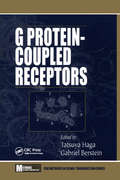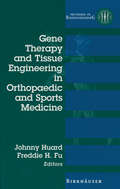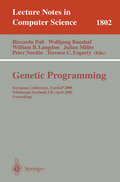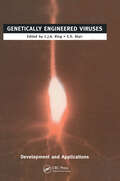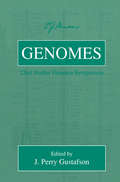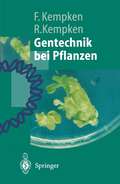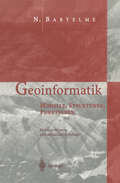- Table View
- List View
Future Directions for Intelligent Systems and Information Sciences: The Future of Speech and Image Technologies, Brain Computers, WWW, and Bioinformatics (Studies in Fuzziness and Soft Computing #45)
by Nikola KasabovThis edited volume comprises invited chapters that cover five areas of the current and the future development of intelligent systems and information sciences. Half of the chapters were presented as invited talks at the Workshop "Future Directions for Intelligent Systems and Information Sciences" held in Dunedin, New Zealand, 22-23 November 1999 after the International Conference on Neuro-Information Processing (lCONIPI ANZIISI ANNES '99) held in Perth, Australia. In order to make this volume useful for researchers and academics in the broad area of information sciences I invited prominent researchers to submit materials and present their view about future paradigms, future trends and directions. Part I contains chapters on adaptive, evolving, learning systems. These are systems that learn in a life-long, on-line mode and in a changing environment. The first chapter, written by the editor, presents briefly the paradigm of Evolving Connectionist Systems (ECOS) and some of their applications. The chapter by Sung-Bae Cho presents the paradigms of artificial life and evolutionary programming in the context of several applications (mobile robots, adaptive agents of the WWW). The following three chapters written by R.Duro, J.Santos and J.A.Becerra (chapter 3), GCoghill . (chapter 4), Y.Maeda (chapter 5) introduce new techniques for building adaptive, learning robots.
Fuzzy Systems and Soft Computing in Nuclear Engineering (Studies in Fuzziness and Soft Computing #38)
by Da RuanFuzzy systems and soft computing are new computing techniques that are tolerant to imprecision, uncertainty and partial truths. Applications of these techniques in nuclear engineering present a tremendous challenge due to its strict nuclear safety regulation. The fields of nuclear engineering, fuzzy systems and soft computing have nevertheless matured considerably during the last decade. This book presents new application potentials for Fuzzy Systems and Soft Computing in Nuclear Engineering. The root of this book can be traced back to the series of the first, second and third international workshops on Fuzzy Logic and Intelligent Technologies in Nuclear Science (FUNS), which were successfully held in Mol, September 14-16, 1994 (FLINS'94), in Mol, September 25-27, 1996 (FLINS'96), and in Antwerp, September 14-16, 1998 (FLINS'98). The conferences were organised by the Belgian Nuclear Research Centre (SCKeCEN) and aimed at bringing together scientists, researchers, and engineers from academia and industry, at introducing the principles of fuzzy logic, neural networks, genetic algorithms and other soft computing methodologies, to the field of nuclear engineering, and at applying these techniques to complex problem solving within nuclear industry and related research fields. This book, as its title suggests, consists of nuclear engineering applications of fuzzy systems (Chapters 1-10) and soft computing (Chapters 11-21). Nine pertinent chapters are based on the extended version of papers at FLINS'98 and the other 12 chapters are original contributions with up-to-date coverage of fuzzy and soft computing applications by leading researchers written exclusively for this book.
G Protein-Coupled Receptors
by Gabriel BersteinCovering recently developed methods in membrane-bound receptors, this book emphasizes receptor structure and function, knowledge of which is essential to the study of signal transduction.G Protein-Coupled Receptors has culled contributors from domestic and international sources, providing a broad base of knowledge. Some topics covered are the r
G Protein-Coupled Receptors
by Tatsuya Haga and Gabriel BersteinCovering recently developed methods in membrane-bound receptors, this book emphasizes receptor structure and function, knowledge of which is essential to the study of signal transduction.G Protein-Coupled Receptors has culled contributors from domestic and international sources, providing a broad base of knowledge. Some topics covered are the r
Gas-Phase Combustion Chemistry
by W. C. Jr. GardinerSuperseding Gardiner's "Combustion Chemistry", this is an updated, comprehensive coverage of those aspects of combustion chemistry relevant to gas-phase combustion of hydrocarbons. The book includes an extended discussion of air pollutant chemistry and aspects of combustion, and reviews elementary reactions of nitrogen, sulfur and chlorine compounds that are relevant to combustion. Methods of combustion modeling and rate coefficient estimation are presented, as well as access to databases for combustion thermochemistry and modeling.
Gauge Theory of Weak Interactions
by Walter Greiner Berndt MüllerThis carefully developed and well introduced text treats the unification of electromagnetic and weak interactions and considers related phenomena, providing an accessible introduction to the field. This third edition has been newly revised.
Gene Therapy and Tissue Engineering in Orthopaedic and Sports Medicine (Methods in Bioengineering)
by Johnny Huard Freddie H. FuThis book has been written in response to the many physicians and scien tists working on the development of biological approaches to providing therapies for many orthopaedic disorders as well as to improving the healing of many tissues of the musculoskeletal system. The first goal of this book is to make the language compatible between the bench scientist and the clinician working in orthopaedic and sports medicine in order to cover specific areas of the orthopaedic discipline where the treatment can be improved and/or changed by the advancements in molecular medicine. Advancements in molecular biology, which encompass the study of the genetic basis of disease, have produced new diagnostic methods and drug therapies for genetic diseases and acquired disorders. The growth in the understanding of human genetics has also led to the initiation of many human gene therapy experiments. Although many approved therapeutic clinical trials using this new technology have been performed in the last ten years, the first clinical trial using this technology in the area of orthopaedics was performed at the University of Pittsburgh.
Gene Therapy in Inflammatory Diseases (Progress in Inflammation Research)
by Prof. Dr. Michael J. ParnhamGene therapy for inflammatory diseases is a new , burgeoning field of medicine. Edited by the undisputed pioneers of this area of research, this volume is the first devoted to its topic. It contains thirteen chapters, each written by leaders in their respective fields, that summarize the state of the art in developing novel, gene based treatments for inflammatory diseases. As well as providing an introduction to the basic concepts of gene therapy and the use of naked DNA approaches, the book describes the advances that have been made in applying them to arthritis, lupus, multiple sclerosis, diabetes, Sjogren`s syndrome and transplantation.One chapter is devoted to discussing the first human clinical trials that apply gene therapy to the treatment of an inflammatory disease. As well as providing novel therapeutic approaches, gene therapy facilitates the development of new and improved animal models of disease; a chapter describing these advances is also included. As an up-to-date, timely book written by th
The Genetic Basis of Male Infertility (Results and Problems in Cell Differentiation #28)
by Lorand B. SzalayEvery year there are new and exciting developments in assisted human reproduction, but how much do we really know about the underlying causes of infertility? This volume explores recent progress in the understanding of the genetics of spermatogenesis and male infertility. Topics include fundamental advances and current problems in the development and function of the testis, an outline of clinical findings in male infertility and an overview of the role of the Y chromosome in male fertility. Comprehensive critiques of posttranscriptional control during spermatogenesis, mammalian meiotic sterility, and comparative genetics of human spermatogenesis from the perspective of yeast, Drosophila and mice provide a global overview of the field.
Genetic Engineering: Principles and Methods (Genetic Engineering: Principles and Methods #22)
by Jane K. SetlowThis volume, as with the previous books in the series, presents state-of-the-art discussions in genetics and genetic engineering by focusing on plant science and technology, agriculture, cell biology, and medical research.
Genetic Influences on Human Fertility and Sexuality: Theoretical and Empirical Contributions from the Biological and Behavioral Sciences
by Warren B. Miller David C. Rowe Joseph LeeRodgersRecent work in quantitative biology has shown theoretically why Fisher's Fundamental Theorem of Natural Selection does not preclude genetic influences on fertility, sexuality, and related processes. Genetic Influences on Human Fertility and Sexuality takes the next step, and presents a number of successful empirical searches for such genetic influence on a broad range of processes, such as puberty, marriage, sexual behavior, and twinning. Employing a broad range of methodological approaches, including molecular and behavioral genetics, this book weaves a new theoretical framework that shows how genes can help relate fertility planning to fertility outcome, and how puberty, sexuality, marriage, and reproduction can be conceptually linked through the genes that contribute to individual differences in the human process.
Genetic Programming: European Conference, EuroGP 2000 Edinburgh, Scotland, UK, April 15-16, 2000 Proceedings (Lecture Notes in Computer Science #1802)
by Riccardo Poli Wolfgang Banzhaf William B. Langdon Julian F. Miller Peter Nordin Terence C. FogartyThis volume contains the proceedings of EuroGP 2000, the European Conf- ence on Genetic Programming, held in Edinburgh on the 15th and 16th April 2000. This event was the third in a series which started with the two European workshops: EuroGP’98, held in Paris in April 1998, and EuroGP’99, held in Gothenburg in May 1999. EuroGP 2000 was held in conjunction with EvoWo- shops 2000 (17th April) and ICES 2000 (17th-19th April). Genetic Programming (GP) is a growing branch of Evolutionary Compu- tion in which the structures in the population being evolved are computer p- grams. GP has been applied successfully to a large number of di?cult problems like automatic design, pattern recognition, robotic control, synthesis of neural networks, symbolic regression, music and picture generation, biomedical app- cations, etc. In recent years,even human-competitive results have been achieved by a number of groups. EuroGP 2000, the ?rst evolutionary computation conference of the new m- lennium, was the biggest event devoted to genetic programming to be held in Europe in 2000. It was a high quality conference where state-of-the-art work on the theory of GP and applications of GP to real world problems was presented.
Genetically Engineered Viruses: Development and Applications
by Christopher J. A. Ring Edward D. BlairThis book combines an up-to-date summary of how best to genetically engineer viruses with an overview of basic virology. This unique combination makes it an invaluable research tool for virologists and molecular biologists seeking to exploit viruses for a range of applications. Written by highly respected authors, the book also provides comparisons to and guidelines for the use of viruses in difference applications.
Genetically Engineered Viruses: Development and Applications
This book combines an up-to-date summary of how best to genetically engineer viruses with an overview of basic virology. This unique combination makes it an invaluable research tool for virologists and molecular biologists seeking to exploit viruses for a range of applications. Written by highly respected authors, the book also provides comparisons to and guidelines for the use of viruses in difference applications.
Genomes (Stadler Genetics Symposia Series)
by J. Perry Gustafson R. B. FlavellThis volume brings together the disciplines of plant and animal genome research, and serves as an opportunity for scientists from both fields to compare results, problems and prospects.
Gentechnik bei Pflanzen: Chancen und Risiken (Springer-Lehrbuch)
by Frank Kempken Renate KempkenIst gentechnisch veränderte Nahrung schädlich? Bieten gentechnisch erzeugte Pflanzen ökologische Vorteile? Können sie die Ernährung in Entwicklungsländern verbessern? Das Buch beantwortet leicht verständlich alle Fragen zu den Chancen und Risiken der pflanzlichen Gentechnik. Wer sachkundig mitreden möchte, findet hier fundierte Argumentationshilfen.
Geoenvironmental Engineering: Principles and Applications
by Hilary I. Inyang Lakshmi Reddi"Applies science and engineering principles to the analysis, design, and implementation of technical schemes to characterize, treat, modify, and reuse/store waste and contaminated media. Includes site remediation."
Geoinformatik: Modelle · Strukturen · Funktionen
by Norbert Bartelme'Geoinformatik' erläutert die Grundlagen der Modellierung von Geoinformation in Datenbanken und informationsverarbeitenden Systemen. Damit spricht es einen breiten Personenkreis aus der Geographie, dem Vermessungswesen, den angewandten Geowissenschaften und auch aus den Informationswissenschaften an, der sich ein Bild vom aktuellen Wissensstand und den Anwendungsmöglichkeiten der Geoinformatik machen will. Das Spektrum reicht dabei von der Modellierung von Geoobjekten im Raum bis zu ihrer Schematisierung in Datenbanken vor dem Hintergrund typischer GIS-Applikationen.
Geometry and Quantum Physics: Proceedings of the 38. Internationale Universitätswochen für Kern- und Teilchenphysik, Schladming, Austria, January 9–16, 1999 (Lecture Notes in Physics #543)
by H. Gausterer H. Grosse L. PittnerIn modern mathematical physics, classical together with quantum, geometrical and functional analytic methods are used simultaneously. Non-commutative geometry in particular is becoming a useful tool in quantum field theories. This book, aimed at advanced students and researchers, provides an introduction to these ideas. Researchers will benefit particularly from the extensive survey articles on models relating to quantum gravity, string theory, and non-commutative geometry, as well as Connes' approach to the standard model.
The Geometry of Spacetime: An Introduction to Special and General Relativity (Undergraduate Texts in Mathematics)
by James J. CallahanHermann Minkowski recast special relativity as essentially a new geometric structure for spacetime. This book looks at the ideas of both Einstein and Minkowski, and then introduces the theory of frames, surfaces and intrinsic geometry, developing the main implications of Einstein's general relativity theory.
The German Chemical Industry in the Twentieth Century (Chemists and Chemistry #18)
by John E. LeschIn the twentieth century, dyes, pharmaceuticals, photographic products, explosives, insecticides, fertilizers, synthetic rubber, fuels, and fibers, plastics, and other products have flowed out of the chemical industry and into the consumer economies, war machines, farms, and medical practices of industrial societies. The German chemical industry has been a major site for the development and application of the science-based technologies that gave rise to these products, and has had an important role as exemplar, stimulus, and competitor in the international chemical industry. This volume explores the German chemical industry's scientific and technological dimension, its international connections, and its development after 1945. The authors relate scientific and technological change in the industry to evolving German political and economic circumstances, including two world wars, the rise and fall of National Socialism, the post-war division of Germany, and the emergence of a global economy. This book will be of interest to historians of modern Germany, to historians of science and technology, and to business and economic historians.
Germany’s Technological Performance: A Study on Behalf of the German Federal Ministry of Education and Research (ZEW Economic Studies #8)
by H. Legler G. Licht A. SpielkampMaintaining the innovation capabilities of firms, employees and institutions is a key component for the generation of sustainable growth, employment, and high income in industrial societies. Gaining insights into the German innovation system and the institutional framework is as important to policy making as is data on the endowment of the German economy with factors fostering innovation and their recent development. Germany's Federal Ministry of Education and Research has repeatedly commissioned reports on the competitive strength of the German innovation system since the mid-eighties. The considerable attention that the public and the political, administrative and economic actors have paid to these reports in the past few years proves the strong interest in the assessment of and indicators for the dynamics behind innovation activities. The present study closely follows the pattern of those carried out before. It has been extended, however, to include an extensive discussion on indicators for technological performance and an outline of the key features of the German innovation system.
Globalization and Its Critics: Perspectives from Political Economy (International Political Economy Series)
by NA NAGlobalization and Its Critics challenges the claim that globalization is a clearly understood phenomena whose effects are well known and easily accounted for. It explores the categories we use to think about globalization, the dynamics which are driving it, and the effects which globalizing tendencies are having on the key institutional features of the contemporary world. The contributors examine not only how globalization is refashioning political and economic institutions, but also the way in which specific forms of knowledge and technology are shaping the ongoing dynamic of globalization. The volume concludes with a review of the issues posed by this important debate.
Glycoprotein Methods and Protocols: The Mucins (Methods in Molecular Biology #125)
by Anthony P. CorfieldThe mucins (mucus glycoproteins) have long been a complex corner of glycoprotein biology. While dramatic advances in the separation, structural an- ysis, biosynthesis, and degradation have marked the progress in general glycop- tein understanding, the mucins have lagged behind. The reasons for this lack of progress have always been clear and are only now being resolved. The mucins are very large molecules; they are difficult to separate from other molecules present in mucosal secretions or membranes; they are often degraded owing to natural protective functions or to isolation methodology and their peptide and oligos- charide structures are varied and complex. Understanding these molecules has demanded progress in several major areas. Isolation techniques that protect the intact mucins and allow dissociation from other adsorbed but discrete molecules needed to be developed and accepted by all researchers in the field. Improved methods for the study of very large molecules with regard to their aggregation and polymerization were also needed. Structural analysis of the peptide domains and the multitude of oligosaccharide chains was required for smaller sample sizes, for multiple samples, and in shorter time. In view of these problems it is perhaps not surprising that the mucins have remained a dilemma, of obvious biological importance and interest, but very difficult to analyze.



